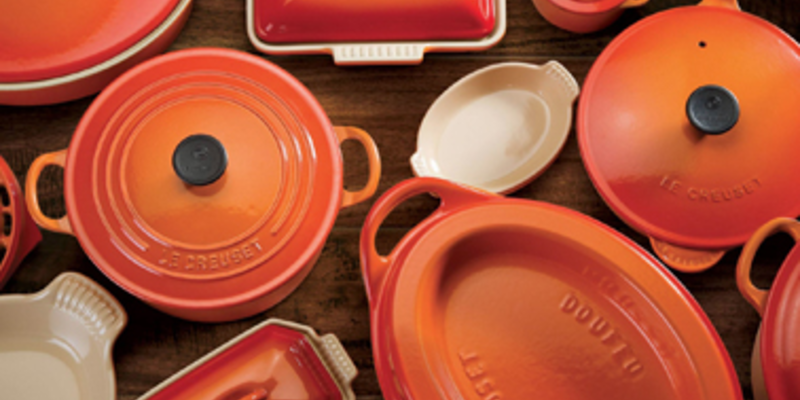
 I have an unusual appreciation for my two Le Creuset Dutch ovens. I think it's fair to say that I love them. Walking around the Charleston Wine + Food Festival the last few days under the constant assault of sponsor Le Creuset's orange bags and banners has given me added cause to ponder just why I so love my Le Creuset.
I have an unusual appreciation for my two Le Creuset Dutch ovens. I think it's fair to say that I love them. Walking around the Charleston Wine + Food Festival the last few days under the constant assault of sponsor Le Creuset's orange bags and banners has given me added cause to ponder just why I so love my Le Creuset.
Enamel-coated cast iron beauties, they're loyal, dependable and will last forever—unlike a lot of people (men, specifically) that I know. Even though they're heavy and situated in a very high, inconvenient cupboard, I go to them at least once a week, navigating an awkward step ladder to do so. Heck—I sometimes think that I would navigate Everest, or at least try to, to get to my Le Creuset. I know without a shadow of a doubt that they would be rescued just behind my cat and dog if ever the house caught on fire.
I reach for these large pot friends when I need reliability, comfort, and some soothing long-cooked food goodeness that makes the house smell soulful and fragrant. That's exactly what these vessels are made for—braising, or long, slow cooking in liquid with aromats and seasoning (aka my favorite kind of food). I know that when I've made the effort to get out my Le Creuset, I'm in for some blissful cooking delight and will be rewarded with something delicious in a few short hours.
They come in happy colors, too, like my French blue and lime green beauties. Once they've done their job, a good washing and air dry returns them to their clean, practically indestructable state. I once faltered in my loyalty to my Le Creuset Dutch oven, swayed by the similar colors and shapes of a much lower-priced copycat variety I found at Harris Teeter a few years ago. I bought a couple of casserole dishes and one cute round, petite wanna-be Le Creuset Dutch oven. After three or four uses, their cheap teflon coating was scratched and they'd lost their luster. I still use them, but I bring out my Le Creuset for the big gun cooking, like this delicious braised pork stew to follow—a recipe that always makes me and my guests very happy. I hope it will you, too.
Sweet and Soulful Pork and Apple Stew
[Adapted from Southern Farmers Market Cookbook (Gibbs Smith) by Holly Herrick]
(Serves 6)
Boston Butt comes from the tough, working muscles of the pig’s shoulder and is a perfect candidate for braising and an open-ended backdrop for myriad flavorings—from sweet to spicy and everything in between. Here, the round, even flavor of the pork dances with the sweetness of the fall apple harvest that lasts long into the winter months. I love a sweet/tart apple, such as a Winesap variety, but mix it up with whatever you have on hand. Don’t substitute processed cider for fresh, however. It just doesn’t deliver the same results. If you’d like to add a last minute pungency-punch, stir in 2 tablespoons of Dijon mustard just before serving. Served over grits, this is the consummate winter or cooler weather comfort food that you’ll remember long after the last spoonful is savored.
INGREDIENTS
1 tablespoon olive oil
1 tablespoon unsalted butter
2 pounds Boston Butt pork shoulder, cut into 2” cubes
1 teaspoon dried sage leaves
Salt and fresh ground pepper to taste
1 medium onion, peeled, halved, and thinly sliced
2 celery stalks, cleaned and cut thinly
3 cloves garlic, minced
2 tablespoons All-Purpose flour
2 cups fresh apple cider
1 cup water or chicken stock
2 Winesap apples, peeled, cored and cut into 1/2" chunks
3 sprigs fresh rosemary bound with a string
DIRECTIONS
In a large Dutch oven or crockpot, heat the olive oil and butter over high heat until bubbling. Add the pork, sage, and season generously with salt and pepper. Brown the pork well on all sides, stirring occasionally, until the meat is colored a deep, golden brown. Remove the meat from the pan and set aside. Reduce the heat to medium. Add the onion, celery, and garlic and cook until just translucent and softened (about 5 minutes), stirring occasionally.
Return the browned pork to the pan. Dust with the flour. Stir to coat and cook through about 3 minutes. Add the cider to deglaze the brown bits from the bottom of the pan. Stir to release all of the browned edges from the pan. Add enough stock or water to cover by a little over half. Add the apples and rosemary bring up to a boil and reduce to a very low simmer over low heat. Cover loosely with a lid and cook until very tender and thickened, 3 to 4 hours. Remove the rosemary bunch and taste to verify seasonings before serving.